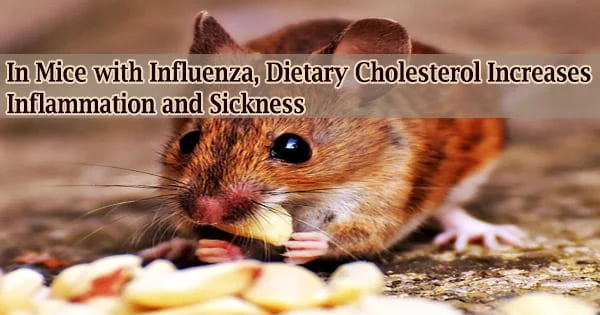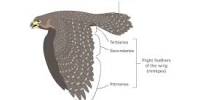High levels of dietary cholesterol make mice worse when infected with influenza, according to a new study from the University of Illinois. The study is the first to relate dietary cholesterol to the worsening of a viral illness.
High-fat diets and high blood cholesterol have previously been related to an increased susceptibility to infection and reduced immunological response. Obesity, for example, is a well-known risk factor for severe COVID and influenza sickness. However, few studies have examined the role of cholesterol in these infections, and none have examined the impact of dietary cholesterol.
“We knew high serum cholesterol levels can lead to a higher risk of sepsis in influenza infections and that statins cholesterol-lowering medications can improve survival during influenza pneumonia, SARS-CoV-2 infection, and sepsis. But it wasn’t clear whether or how dietary cholesterol was involved,” says Allison Louie, lead author on the Journal of Immunology study and doctoral student in the Neuroscience Program at Illinois.
Influenza, also known as “the flu,” is a contagious respiratory illness caused by influenza viruses. It can cause mild to severe disease, as well as death in some cases. The easiest approach to avoid the flu is to get vaccinated every year.
Cholesterol is a necessary component of the human body. It’s a component of our cell membranes, and it aids in the production of hormones and vitamin D, as well as healthy immune cell activity. Our bodies make it for us, and we only need a small amount of it from our diets.
In truth, dietary cholesterol has no effect on circulating cholesterol levels in healthy people and does not increase the risk of cardiovascular disease.
That’s one of the reasons the Dietary Guidelines for Americans relaxed cholesterol intake restrictions in 2015. When it comes to infectious disease in mice, however, Louie’s research reveals that dietary cholesterol, even without increasing dietary fat, may make a difference.
A so-called cytokine storm during severe disease results in excessive inflammation that can be damaging to the host. Along those lines, we found that more cytokine-producing cells had infiltrated the lungs of the mice fed cholesterol, which may have contributed to them being sicker.
Allison Louie
Louie and his co-authors Andrew Steelman and Joseph Tingling fed mice either regular rat chow or a diet enriched with 2% cholesterol. Mice were infected with a mouse-adapted human influenza A virus after five weeks on the diets.
Weight reduction, food intake, and illness behavior were all tracked by the study’s researchers. They also kept track of blood cholesterol levels, immunological responses, and viral load in the lungs at various stages throughout the infection.
“Across four cohorts, the cholesterol-fed mice had consistently higher morbidity,” Louie says. “They exhibited greater weight loss and sickness behavior.”
Because viruses require cholesterol for cell entry and multiplication, the high-cholesterol diet had the potential to increase viral load in the lungs. However, this is not what the researchers discovered.
“Our plaque assay did not show a significant difference in viral load in the lungs of the two groups of mice,” says Tingling, a postdoctoral researcher in the Department of Animal Sciences at Illinois. “It’s very important to consider not just the infectious agent, but the host immune system.”
The researchers discovered that mice on a high-cholesterol diet were worse as their immune systems malfunctioned. Fat can have an immunosuppressive impact, which can be harmful during an infection.
The cholesterol-fed mice, on the other hand, did not have an underactive immune system, according to the researchers. Cholesterol, on the other hand, boosted the amount of immune cells that produce cytokines in the lungs.
“A so-called cytokine storm during severe disease results in excessive inflammation that can be damaging to the host. Along those lines, we found that more cytokine-producing cells had infiltrated the lungs of the mice fed cholesterol, which may have contributed to them being sicker,” Louie says.
“It’s a double-edged sword. You want to be able to mount an effective immune response, but excessive inflammation is detrimental.”
Unfortunately, the effects of dietary cholesterol on influenza morbidity persisted after mice stopped consuming it. The researchers fed mice a high-cholesterol diet for five weeks before switching them to a regular diet. Even when those mice were given influenza, they became sicker than mice that had never eaten a high-cholesterol diet.
“We were thinking this dietary component is a highly modifiable factor. Perhaps it would only have a transient effect. But ultimately we found that five additional weeks on a normal diet was not enough time to fully reverse the detrimental effects of cholesterol,” Louie says.
Surprisingly, even before the mice were infected with influenza, inflammatory alterations in the lungs could be seen in the high-cholesterol mice.
“Some of the changes in the lungs’ immune function were already present before infection. It would be interesting to see exactly how dietary cholesterol increased inflammation prior to infection,” says corresponding author Steelman, associate professor in the Department of Animal Sciences, the Neuroscience Program, and the Division of Nutritional Sciences at Illinois.
“Nevertheless, our data collectively show that dietary cholesterol increased morbidity in influenza-infected mice. The response appeared to be a result of an aberrant immune response occurring in the lungs rather than an effect of the virus itself. These results demonstrate the need to consider how host factors contribute to disease outcome.”
The University of Illinois Urbana-College Champaign’s of Agricultural, Consumer, and Environmental Sciences houses the Department of Animal Sciences and the Division of Nutritional Sciences.
















